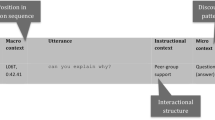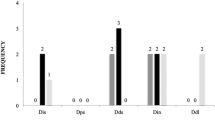Abstract
As a responsive article to Miranda Rocksén’s paper “The many roles of ‘explanation’ in science education: a case study”, this paper aims to emphasize the importance of the two central themes of her paper: dialogic approaches in science education and the role of explanations in science classrooms. I start discussing the concepts of dialogue and dialogism in science classrooms contexts. Dialogism is discussed as the basic tenet from which Rocksén developed her research design and methods. In turn, dialogues in science classrooms may be considered as a particular type of discourse that allows the students’ culture, mostly based on everyday knowledge, and the science school culture, related to scientific knowledge and language to be interwoven. I argue that in school, science teachers are always committed to the resolution of differences according to a scientific position for the knowledge to be constructed. Thus, the institution of schooling constrains the ways in which dialogue can be conducted in the classrooms, as the scientific perspective will be always, beforehand, the reference for the conclusions to be reached. The second theme developed here, in dialogue with Rocksén, is about explanations in science classrooms. Based on Jean Paul Bronckart (Atividade de linguagem, textos e discursos: por um interacionismo sócio-discursivo, Educ, São Paulo, 1999), the differences and relationship between explanation and argumentation as communicative acts are re-discussed as well its practical consequences to science teaching. Finally, some epistemological questions are raised about the status of scientific explanations in relation to non-scientific ones.
Resumo
Como uma resposta ao artigo de Miranda Rocksén “The many roles of ‘explanation’ in science education: a case study”, este trabalho tem como objetivo enfatizar a importância de dois temas desenvolvidos pela autora: abordagens dialógicas na educação científica e o papel do explicações em aulas de ciências. Inicio com a discussão dos conceitos de diálogo e dialogismo nos contextos da comunicação em salas de aula de ciências. O dialogismo é discutido enquanto princípio básico que fundamenta o desenho e a metodologia da pesquisa desenvolvida por Rocksén. Por sua vez, interações dialógicas em aulas de ciências podem ser consideradas como um tipo particular de discurso que permite o entrelaçamento entre a cultura dos alunos, fortemente baseada no conhecimento da vida cotidiana, e a cultura da ciência escolar, relacionada ao conhecimento e à linguagem científicos. Nesse sentido, argumento que no contexto escolar os professores de ciências estão sempre comprometidos a perspectiva científica ao lidarem com a resolução de diferenças acerca do conhecimento a ser construído pelos estudantes. Desse modo, o contexto escolar restringe e condiciona os modos como o diálogo pode ser conduzido nas salas de aula, uma vez que a perspectiva científica será sempre, de antemão, balizadora das conclusões a serem alcançadas. O segundo tema que me proponho examinar, em diálogo com a pesquisa de Miranda Rocksén, é o das explicações nas aulas de ciências. Com base em Jean Paul Bronckart (Atividade de linguagem, textos e discursos: por um interacionismo sócio-discursivo, Educ, São Paulo, 1999), me proponho a discutir as diferenças e as relações entre explicação e argumentação enquanto atos comunicativos, bem como suas consequências práticas para o ensino de ciências. Finalmente, sugiro algumas reflexões epistemológicas sobre o status de explicações científicas em relação às não-científicas.
Similar content being viewed by others
References
Adams, J.-M. (1990). Eléments de linguistique textuelle. Liège: Mardaga.
Aguiar Jr., O. & Mortimer, E. (2013). Promoting productive dialogic teaching in the classrooms: A challenge to science education. In Esera 2013 Conference Procceddings, Cyprus.
Bakhtin, M. (1981). The dialogic imagination. Austin: University of Texas Press.
Bakhtin, M. (1986). Speech genres and other late essays. Austin: University of Texas Press.
Berland, L., & McNeill, K. (2012). For whom is argument and explanation a necessary distinction? A response to Osborne and Patterson. Science Education, 96, 808–813. doi:10.1002/sce.21000.
Berland, L., & Reiser, B. (2008). Making sense of argumentation and explanation. Science Education, 93, 26–55. doi:10.1002/sce.20286.
Bronckart, J.-P. (1999). Atividade de linguagem, textos e discursos: por um interacionismo sócio-discursivo. São Paulo: Educ.
Bronckart, J.-P. (2006). Atividade de linguagem, discurso e desenvolvimento humano. Campinas: Mercado de Letra.
Ford, M., & Wargo, B. (2012). Dialogic framing of scientific content for conceptual and epistemic understanding. Science Education, 96, 369–391. doi:10.1002/sce.20482.
Horwood, H. (1988). Explanation and description in science teaching. Science Education, 72, 41–49. doi:10.1002/sce.3730720104.
Linell, P. (2009). Rethinking language, mind, and world dialogically: Interactional and contextual theories of human sense-making. Charlotte: Information Age Pub Incorporated.
Mortimer, E. (2010). Thinking and speaking on units of analysis and its role in meaning making. In W.-M. Roth (Ed.), Re/structuring science education (Vol. 2, pp. 145–153). New York: Springer. http://dx.doi.org/10.1007/978-90-481-3996-5_10
Mortimer, E., & El-Hani, C. (2014). Conceptual profiles: A theory of teaching and learning scientific concepts. New York: Springer. (Contemporary Trends and Issues in Science Education, # 42).
Mortimer, E., & Scott, P. (2003). Meaning making in secondary science classrooms. Maidenhead: Open University Press.
O’Connor, C., & Michaels, S. (2007). When is dialogue “dialogic”? Human Development, 50, 275–285. doi:10.1159/000106415.
Ogborn, J., Kress, G., Martins, I., & McGillicuddy, K. (1996). Explaining science in the classroom. Buckingham: Open University Press.
Osborne, J., & Patterson, A. (2012). Scientific argument and explanation: A necessary distinction? Science Education, 95, 627–638. doi:10.1002/sce.20438.
Rommetveit, R. (1974). On message structure: A framework for the study of language and communication. Oxford: Wiley.
Roth, W-M. (2010). Thinking and speaking a dynamic approach. In W.-M. Roth (Ed.), Re/structuring science education (Vol. 2, pp. 113–143). New York: Springer. http://dx.doi.org/10.1007/978-90-481-3996-5_9
Sampson, V., & Blanchard, M. R. (2012). Science teachers and scientific argumentation: Trends in views and practice. Journal of Research in Science Teaching, 49, 1122–1148. doi:10.1002/tea.21037.
Scott, P., Mortimer, E., & Aguiar, O. (2006). The tension between authoritative and dialogic discourse: A fundamental characteristic of meaning making interactions in high school science lessons. Science Education, 90, 605–632. doi:10.1002/sce.20131.
Wells, G. (2007). Semiotic mediation, dialogue and the construction of knowledge. Human Development, 50, 244–274. doi:10.1159/000106414.
Author information
Authors and Affiliations
Corresponding author
Additional information
Lead Editor: C. Murphy.
This paper responds to issues raised in Miranda Rocksén’s paper “The many roles of ‘explanation’ in science education: a case study”. doi:10.1007/s11422-014-9629-5.
Rights and permissions
About this article
Cite this article
Aguiar, O.G. Explanation, argumentation and dialogic interactions in science classrooms. Cult Stud of Sci Educ 11, 869–878 (2016). https://doi.org/10.1007/s11422-015-9694-4
Received:
Accepted:
Published:
Issue Date:
DOI: https://doi.org/10.1007/s11422-015-9694-4




